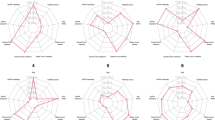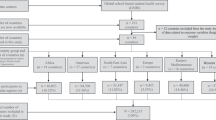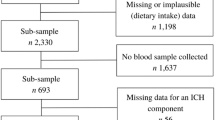Abstract
BACKGROUND/OBJECTIVES:
Individual lifestyle behaviours have independently been associated with cardiovascular diseases (CVD) risk factors in children. This study aimed to identify clustered lifestyle behaviours (dietary, physical activity (PA) and sedentary indicators) and to examine their association with CVD risk factors in children aged 2–9 years.
SUBJECTS/METHODS:
Participants included 4619 children (51.6% boys) from eight European countries participating in the IDEFICS cross-sectional baseline survey (2007–2008). Insulin resistance, total cholesterol/high-density lipoprotein cholesterol ratio, triglycerides, sum of two skinfolds and systolic blood pressure (SBP) z-scores were summed to compute a CVD risk score. Cluster analyses stratified by sex and age groups (2 to <6 years; 6–9 years) were performed using parental-reported data on fruit, vegetables and sugar-sweetened beverages (SSB) consumption, PA performance and television video/DVD viewing.
RESULTS:
Five clusters were identified. Associations between CVD risk factors and score, and clusters were obtained by multiple linear regression using cluster 5 (‘low beverages consumption and low sedentary’) as the reference cluster. SBP was positively associated with clusters 1 (‘physically active’; β=1.34; 95% confidence interval (CI): 0.02, 2.67), 2 (‘sedentary’; β=1.84; 95% CI: 0.57, 3.11), 3 (‘physically active and sedentary’; β=1.45; 95% CI: 0.15, 2.75) and 4 (‘healthy diet’; β=1.83; 95% CI: 0.50, 3.17) in older boys. A positive association was observed between CVD risk score and clusters 2 (β=0.60; 95% CI: 0.20, 1.01), 3 (β=0.55; 95% CI: 0.14, 0.97) and 4 (β=0.60, 95% CI: 0.18, 1.02) in older boys.
CONCLUSIONS:
Low television/video/DVD viewing levels and low SSB consumption may result in a healthier CVD profile rather than having a diet rich in fruits and vegetables or being physically active in (pre-)school children.
This is a preview of subscription content, access via your institution
Access options
Subscribe to this journal
Receive 12 print issues and online access
$259.00 per year
only $21.58 per issue
Buy this article
- Purchase on Springer Link
- Instant access to full article PDF
Prices may be subject to local taxes which are calculated during checkout

Similar content being viewed by others

References
National Cholesterol Education Program (NCEP) Expert Panel on Detection, Evaluation, and Treatment of High Blood Cholesterol in Adults (Adult Treatment Panel III). Third Report of the National Cholesterol Education Program (NCEP) Expert Panel on Detection, Evaluation, and Treatment of High Blood Cholesterol in Adults (Adult Treatment Panel III) final report. Circulation 2002; 106: 3143–3421.
World Health Organization (WHO). The 10 leading causes of death 2008: http://www.who.int/mediacentre/factsheets/fs310/en/index.html (updated 2011; cited 2 Jun 2011).
Kavey RE, Daniels SR, Lauer RM, Atkins DL, Hayman LL, Taubert K . American Heart Association guidelines for primary prevention of atherosclerotic cardiovascular disease beginning in childhood. Circulation 2003; 107: 1562–1566.
Raitakari OT, Juonala M, Kahonen M, Taittonen L, Laitinen T, Maki-Torkko N et al. Cardiovascular risk factors in childhood and carotid artery intima-media thickness in adulthood: the Cardiovascular Risk in Young Finns Study. JAMA 2003; 290: 2277–2283.
Andersen LB, Wedderkopp N, Hansen HS, Cooper AR, Froberg K . Biological cardiovascular risk factors cluster in Danish children and adolescents: the European Youth Heart Study. Prev Med 2003; 37: 363–367.
Ventura EE, Davis JN, Alexander KE, Shaibi GQ, Lee W, Byrd-Williams CE et al. Dietary intake and the metabolic syndrome in overweight Latino children. J Am Diet Assoc 2008; 108: 1355–1359.
Perichart-Perera O, Balas-Nakash M, Rodriguez-Cano A, Munoz-Manrique C, Monge-Urrea A, Vadillo-Ortega F . Correlates of dietary energy sources with cardiovascular disease risk markers in Mexican school-age children. J Am Diet Assoc 2010; 110: 253–260.
Andersen LB, Harro M, Sardinha LB, Froberg K, Ekelund U, Brage S et al. Physical activity and clustered cardiovascular risk in children: a cross-sectional study (The European Youth Heart Study). Lancet 2006; 368: 299–304.
Brage S, Wedderkopp N, Ekelund U, Franks PW, Wareham NJ, Andersen LB et al. Features of the metabolic syndrome are associated with objectively measured physical activity and fitness in Danish children: the European Youth Heart Study (EYHS). Diabetes Care 2004; 27: 2141–2148.
Jiménez-Pavón D, Ruiz JR, Ortega FB, Artero EG, España-Romero V, Castro-Piñero J et al. Physical activity, fitness and fatness in children and adolescents. In: Moreno LA, Pigeot I, Ahrens W (eds) Epidemiology of Obesity in Children and Adolescents Prevalence and Etiology 1st edition Springer Series: New York, USA, 2011, pp 347–366.
Day RS, Fulton JE, Dai S, Mihalopoulos NL, Barradas DT . Nutrient intake, physical activity, and CVD risk factors in children: Project HeartBeat!. Am J Prev Med 2009; 37 (Suppl 1), S25–S33.
Ekelund U, Brage S, Froberg K, Harro M, Anderssen SA, Sardinha LB et al. TV viewing and physical activity are independently associated with metabolic risk in children: the European Youth Heart Study. PLoS Med 2006; 3: e488.
Treuth MS, Catellier DJ, Schmitz KH, Pate RR, Elder JP, McMurray RG et al. Weekend and weekday patterns of physical activity in overweight and normal-weight adolescent girls. Obesity (Silver Spring) 2007; 15: 1782–1788.
Katzmarzyk PT, Church TS, Craig CL, Bouchard C . Sitting time and mortality from all causes, cardiovascular disease, and cancer. Med Sci Sports Exerc 2009; 41: 998–1005.
Sabbe D, De Bourdeaudhuij I, Legiest E, Maes L . A cluster-analytical approach towards physical activity and eating habits among 10-year-old children. Health Educ Res 2008; 23: 753–762.
Ahrens W, Bammann K, Siani A, Buchecker K, De Henauw S, Iacoviello L et al. The IDEFICS cohort: design, characteristics and participation in the baseline survey. Int J Obes (Lond) 2011; 35 (Suppl 1), S3–15.
United Nations. Educational Scientific and Cultural Organization (UNESCO). International Standard Classification of Education ISCED 2006:http://www.uis.unesco.org/Education/Pages/international-standard-classification-of-education.aspx (accessed 2 February 2012).
Huybrechts I, Bornhorst C, Pala V, Moreno LA, Barba G, Lissner L et al. Evaluation of the Children's Eating Habits Questionnaire used in the IDEFICS study by relating urinary calcium and potassium to milk consumption frequencies among European children. Int J Obes (Lond) 2011; 35 (Suppl 1), S69–S78.
Lanfer A, Hebestreit A, Ahrens W, Krogh V, Sieri S, Lissner L et al. Reproducibility of food consumption frequencies derived from the Children’s Eating Habits Questionnaire used in the IDEFICS study. Int J Obes (Lond) 2011; 35 (Suppl 1), S61–S68.
Bel-Serrat S, Mouratidou T, Pala V, Huybrechts I, Bornhorst C, Fernandez-Alvira JM et al. Relative validity of the Children's Eating Habits Questionnaire-food frequency section among young European children: the IDEFICS Study. Public Health Nutr 2013; 4: 1–11.
Alpert BS . Validation of the Welch Allyn Spot Vital Signs blood pressure device according to the ANSI/AAMI SP10: 2002. Accuracy and cost-efficiency successfully combined. Blood Press Monit 2007; 12: 345–347.
Peplies J, Gunther K, Bammann K, Fraterman A, Russo P, Veidebaum T et al. Influence of sample collection and preanalytical sample processing on the analyses of biological markers in the European multicentre study IDEFICS. Int J Obes (Lond) 2011; 35 (Suppl 1), S104–S112.
Panz VR, Raal FJ, Paiker J, Immelman R, Miles H . Performance of the CardioChek PA and Cholestech LDX point-of-care analysers compared to clinical diagnostic laboratory methods for the measurement of lipids. Cardiovasc J S Afr 2005; 16: 112–117.
Matthews DR, Hosker JP, Rudenski AS, Naylor BA, Treacher DF, Turner RC . Homeostasis model assessment: insulin resistance and beta-cell function from fasting plasma glucose and insulin concentrations in man. Diabetologia 1985; 28: 412–419.
Milligan CW, Cooper MC . Methodology review: clustering methods. Appl Psychol Measure 1987; 11: 329–354.
Gore PA . Cluster analysis. In: Tinsley HEA, Brown SD (eds) Handbook of applied multivariate statistics and mathematical modeling 1st edition, Academic Press: San Diego, CA, 2000, pp 297–321.
Everitt B (ed). Cluster analysis 2nd edition Heinemann Educational Books: London, UK, 1980.
Viera AJ, Garrett JM . Understanding interobserver agreement: the kappa statistic. Fam Med 2005; 37: 360–363.
Cameron AJ, Crawford DA, Salmon J, Campbell K, McNaughton SA, Mishra GD et al. Clustering of obesity-related risk behaviors in children and their mothers. Ann Epidemiol 2011; 21: 95–102.
Ottevaere C, Huybrechts I, Benser J, De Bourdeaudhuij I, Cuenca-Garcia M, Dallongeville J et al. Clustering patterns of physical activity, sedentary and dietary behavior among European adolescents: The HELENA study. BMC Public Health 2011; 11: 328.
Vereecken CA, Inchley J, Subramanian SV, Hublet A, Maes L . The relative influence of individual and contextual socio-economic status on consumption of fruit and soft drinks among adolescents in Europe. Eur J Public Health 2005; 15: 224–232.
Sallis JF, Prochaska JJ, Taylor WC . A review of correlates of physical activity of children and adolescents. Med Sci Sports Exerc 2000; 32: 963–975.
de Bourdeaudhuij I, van Oost P . A cluster-analytical approach toward physical activity and other health related behaviors. Med Sci Sports Exerc 1999; 31: 605–612.
Olza J, Gil-Campos M, Leis R, Bueno G, Aguilera CM, Valle M et al. Presence of the metabolic syndrome in obese children at prepubertal age. Ann Nutr Metab 2011; 58: 343–350.
Viner RM, Segal TY, Lichtarowicz-Krynska E, Hindmarsh P . Prevalence of the insulin resistance syndrome in obesity. Arch Dis Child 2005; 90: 10–14.
Tremblay MS, LeBlanc AG, Kho ME, Saunders TJ, Larouche R, Colley RC et al. Systematic review of sedentary behaviour and health indicators in school-aged children and youth. Int J Behav Nutr Phys Act 2011; 8: 98.
Kondaki K, Grammatikaki E, Jimenez-Pavon D, De Henauw S, Gonzalez-Gross M, Sjostrom M et al. Daily sugar-sweetened beverage consumption and insulin resistance in European adolescents: the HELENA (Healthy Lifestyle in Europe by Nutrition in Adolescence) Study. Public Health Nutr 2013; 16: 479–486.
Mouratidou T, Mesana MI, Manios Y, Koletzko B, Chinapaw MJ, De Bourdeaudhuij I et al. Assessment tools of energy balance-related behaviours used in European obesity prevention strategies: review of studies during preschool. Obes Rev 2012; 13 (Suppl 1), 42–55.
Vilhjalmsson R, Kristjansdottir G . Gender differences in physical activity in older children and adolescents: the central role of organized sport. Soc Sci Med 2003; 56: 363–374.
Acknowledgements
We thank the children, their parents, teachers and principals for kindly volunteering to participate in this project. This work was done as part of the IDEFICS Study (http://www.idefics.eu). We gratefully acknowledge the financial support of the European Community within the Sixth RTD Framework Programme Contract No. 016181 (FOOD). The information in this document reflects the author’s view and is provided as is. SBS was funded by a grant from the Aragóns’ Regional Government (Diputación General de Aragón, DGA). AMPS received financial support by Fundación Cuenca Villoro (Spain). This analysis was also supported by the European Regional Development Fund (MICINN-FEDER).
Author information
Authors and Affiliations
Consortia
Corresponding author
Ethics declarations
Competing interests
The authors declare no conflict of interest.
Rights and permissions
About this article
Cite this article
Bel-Serrat, S., Mouratidou, T., Santaliestra-Pasías, A. et al. Clustering of multiple lifestyle behaviours and its association to cardiovascular risk factors in children: the IDEFICS study. Eur J Clin Nutr 67, 848–854 (2013). https://doi.org/10.1038/ejcn.2013.84
Received:
Revised:
Accepted:
Published:
Issue Date:
DOI: https://doi.org/10.1038/ejcn.2013.84
Keywords
This article is cited by
-
Trajectories of lifestyle patterns from 2 to 8 years of age and cardiometabolic risk in children: the GUSTO study
International Journal of Behavioral Nutrition and Physical Activity (2024)
-
Clustering of diet, physical activity and sedentary behaviour and related physical and mental health outcomes: a systematic review
BMC Public Health (2023)
-
Clustering of lifestyle behaviors and adiposity in early adolescents in Spain: findings from the SI! Program for Secondary Schools
BMC Public Health (2023)
-
Lifestyle behaviors clusters in a nationwide sample of Spanish children and adolescents: PASOS study
Pediatric Research (2023)
-
Sugar-sweetened beverage intake associations with fasting glucose and insulin concentrations are not modified by selected genetic variants in a ChREBP-FGF21 pathway: a meta-analysis
Diabetologia (2018)


